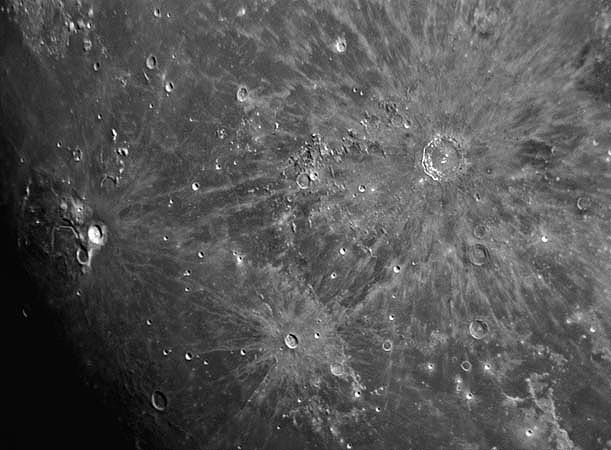July 30, 2008
Splayed Rays - Click Here for the August 1 LPOD!

image by Christophe Behaegel
This is a rerelease of an LPOD that originally appeared May 8, 2005. I am at a NASA meeting at Langley Research Center in southern Virginia, and had to drive here because the airline overbooked. Tomorrow we have a 10 hr drive to get back home (after the meeting ends) so I won't have time to make an LPOD! Thanks.
Did you ever put a magnet under a sheet of paper and sprinkle iron fillings on top? Did you ever do it with three magnets? If so you’d get something similar to this high sun view of rays splaying out from Copernicus (top right), Kepler (lower center) and Aristarchus (middle left). The rays radiate in all directions, and some seem to connect the three craters into a giant triangle. This image shows the variations in the nature of rays, even at a single crater. Rays are perhaps the most difficult type of lunar features to classify, and no classification scheme is commonly used to describe their shapes. Most of the rays from these three craters are relatively narrow but some are much wider. Copernicus has narrow, wispy rays extending in all directions, and wide, semi-parallel rays leading towards Aristarchus and crossing Imbrium. Kepler’s rays are mostly thin and non-distinct to the east, but there are four broad rays to the west, with sharp boundaries with the maria. Aristarchus’ rays are the least conspicuous of the three, and are most visible to its east. All three craters are surrounded by broad annular regions about 1-2 crater diameters wide. This is equivalent to the bright nimbus often seen around tiny fresh craters at full Moon. Curiously, there is not a modern catalog of rayed craters; one must go back to the classical moon mappers such as Schmidt and Elger to find a thorough listing.
Chuck Wood
Technical Details
Since I wrote this the Moon Wiki has created a growing list of ray craters (based on the Elger list), but there is still no ray classification system.
Yesterday's LPOD: Sunrise On an Unflat Plain
Tomorrow's LPOD: An Overlooked Gem
COMMENTS?
Register, Log in, and join in the comments.



